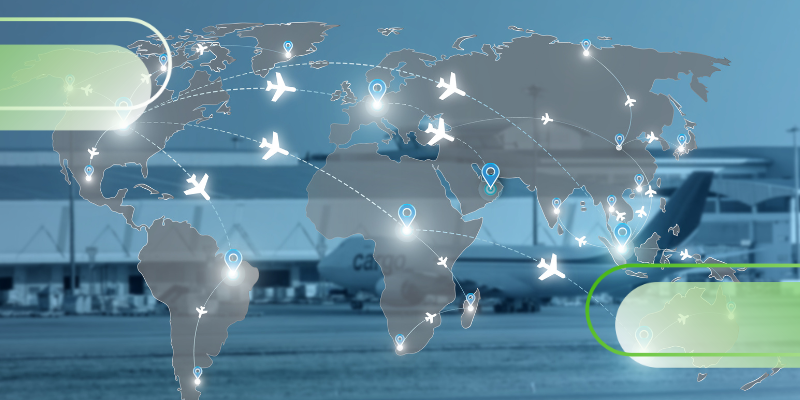In today’s interconnected world, where businesses thrive internationally, the intricate web of global shipping routes forms the backbone of international trade. Understanding the importance of these routes is crucial for businesses looking to have a competitive edge in the global economy. In this blog post, we delve into the most commonly asked questions about global shipping routes and how ePost Global optimizes our routes for business success.

The Most Commonly Asked Questions about Global Shipping Routes
What is the role of global shipping routes?
Global shipping routes serve as intricate pathways that link countries and continents, enabling the seamless movement of goods across vast distances. These routes encompass a network of maritime, air, and land connections, connecting major ports, airports, and distribution hubs worldwide.
Maritime routes traverse oceans and seas, connecting continents such as Asia, Europe, North America, and Africa. Air routes facilitate rapid transport, particularly for time-sensitive cargo, while land routes, including railways and highways, enhance connectivity within regions. These interconnected routes create a dynamic and efficient global trade ecosystem, allowing goods to journey from manufacturers to consumers, bridging geographical gaps and cultural differences.
What factors influence route selection?
Selecting the optimal shipping route involves a delicate balance of multiple factors. Distance, time, and cost play pivotal roles, as shorter routes generally lead to reduced transportation expenses and faster delivery times. Geopolitical factors, such as political stability and trade agreements, also shape route choices. Additionally, weather patterns and navigational challenges influence the safety and efficiency of routes, often leading to adjustments in response to changing conditions.
At ePost Global, we strategically utilize a combination of air and ground transport to optimize our global shipping routes, ensuring swift, efficient, and reliable delivery of goods worldwide. This integrated approach allows us to offer flexible and cost-effective solutions tailored to the unique needs of each shipment, whether it’s reaching remote locations or meeting tight delivery timelines.
What are the most common global shipping routes by sea?
As goods travel the world by water, container ships and cargo ships rely on a network of critical shipping trade routes that connect continents, economies, and markets. These sea routes, including some of the busiest shipping lanes globally, are frequented by a vast number of commercial ships. Although there are many routes that exist, there are five major shipping routes that play pivotal roles in maritime shipping.
1. The English Channel – The English Channel, connecting many European countries via the North Sea and the Atlantic Ocean, is crucial for over 500 ships daily that sail its waters, including the Dover Strait – its narrowest point – providing Europe and the UK with vital cargoes.
2. The Strait of Malacca – Connecting the Pacific Ocean and Indian Ocean, the Strait of Malacca stands as the world’s second-busiest waterway, binding major Asian economies like India, China, Japan, Singapore, Malaysia and Indonesia to the global stage.
3. The Panama Canal – The Panama Canal is a man-made pathway that serves as a direct link between the Pacific and Atlantic Oceans and is vital for shipping in South America. A procession of ships, each carrying up to 14,000 TEUs, traverse its series of locks annually.
4. The Suez Canal – The Suez Canal is the shortest sea connection between Europe and Asia, connecting the Mediterranean and the Red Seas by the Isthmus of Suez. Approximately 12% of world trade flows through its waters, allowing for trade to
5. The Strait of Hormuz – The Strait of Hormuz, connected to the Persian Gulf, is a waterway that is used for transportation to Asian markets, powering economies from China and Japan to South Korea and India.
Although sea freight has been a cornerstone of global trade for decades, many businesses, particularly in the eCommerce sector, are increasingly turning to air shipping. This shift is driven by the need for faster delivery times to meet the growing consumer demand for quick and efficient service.

What are the advantages of air shipment over sea?
Air shipment offers several distinct advantages over sea transportation, making it a preferred choice for certain types of cargo and circumstances. The most significant benefit is speed; air freight is considerably faster than sea transport, making it ideal for time-sensitive shipments, such as perishable goods, urgent medical supplies, or high-demand products needing rapid replenishment. This speed also translates to shorter inventory cycles, enabling businesses to operate with leaner inventory levels and respond more swiftly to market changes.
Additionally, air shipment tends to offer higher security levels, reducing the risk of theft or damage, especially crucial for valuable or fragile items. While often more expensive, the reliability and frequency of flights can provide more predictable scheduling and faster turnaround times, which is particularly beneficial for just-in-time (JIT) manufacturing processes. Lastly, air freight, with its extensive global network, offers greater flexibility in routing and destinations, making it easier to ship goods to remote or landlocked areas where sea transport is not an option. These advantages make air shipment a compelling option for businesses prioritizing speed, reliability, and flexibility in their logistics strategy.
Can my shipping choice actually impact my business?
The choice of shipping routes by your shipping partner can significantly impact supply chain efficiency and overall business operations. Optimized routes lead to streamlined transportation, minimizing transit times and reducing inventory holding costs. This, in turn, enhances supply chain responsiveness and agility, allowing businesses to swiftly respond to market fluctuations and customer demands.
Efficient shipping routes also contribute to reduced fuel consumption and greenhouse gas emissions, aligning with many new sustainable business practices. On the other hand, suboptimal routes can result in delays, increased operational costs, and disruptions in the supply chain flow. Therefore, understanding and harnessing the power of shipping routes can make the difference between a well-oiled supply chain that fuels business success and one that struggles to meet market demands.
What are the major benefits of an effective global shipping route?
Global shipping routes have a direct impact on shipping dynamics, including:
The impact on cost
The selection of shipping routes holds a pivotal role in shaping transportation costs. This decision directly impacts the financial performance of shipping operations. By opting for the right routes, shipping companies can efficiently manage expenses. For instance, shorter routes often translate to reduced fuel consumption, lower operational costs, and optimized resource allocation, where suboptimal routes can have the opposite outcome.
The impact on time
Shipping routes also have a direct influence on delivery times, a factor tightly intertwined with customer satisfaction. Optimal routes pave the way for efficient transportation, minimizing transit times and ensuring that goods reach their intended destinations promptly. The alignment between effective route planning and swift deliveries contributes to an enhanced customer experience.
Efficiency in route selection fosters faster delivery times, fostering customer contentment. Businesses that prioritize the optimization of routes consistently meet or surpass delivery expectations. This speed of delivery significantly contributes to building trust and loyalty among customers, an essential factor in maintaining a competitive edge.

How ePost Global optimizes shipping routes
In the dynamic world of global trade, choosing the best shipping routes is crucial. ePost Global combines technology, industry collaboration, and careful considerations to make this choice.
Leveraging technology and data analytics for precision route planning – At the core of ePost Global’s strategy lies a commitment to leveraging cutting-edge technology and data analytics for meticulous route planning. Utilizing sophisticated algorithms and historical shipping data, we identify the most efficient and reliable routes.
Collaboration with industry partners – We understand the critical importance of collaboration. From the moment a package leaves our facility, we work closely with a global network of industry partners to ensure its safe and timely arrival. By engaging with these logistics experts, we gain valuable insights into the most efficient and innovative pathways for land and air transport. This collaboration enables us to navigate through complex logistics networks and ensures that we find the best possible route for each package. Our commitment to working alongside these partners reflects our dedication to the interconnectedness of the logistics ecosystem and our constant pursuit of excellence in delivering your packages.
Balancing cost and time – ePost Global’s route selection strategy is a delicate balancing act. It encompasses more than mere logistics; it involves optimizing cost and time for the benefit of our customers and their businesses.
As ePost Global navigates the many different pathways that make up global shipping routes, we remain steadfast in our commitment to providing efficient and reliable shipping solutions. Through technology-driven route planning, collaboration with industry partners, and the careful balance of various factors, ePost Global charts a course that not only optimizes shipping routes but also supports the growth of global exports, underlining its role as a driving force in the shipping industry.
Partner with ePost Global for optimized shipping routes
Global shipping routes play a vital role in determining business success. They connect nations, enable trade, and impact economies worldwide. It’s essential for businesses to prioritize optimizing these routes, not just for efficiency and cost savings, but also to keep customers satisfied.
At ePost Global, we understand these routes mean new opportunities for your business. To thrive in this dynamic landscape, businesses must stay flexible, proactive, and adaptable. As industries transform and markets evolve, the ability to navigate these changing paths remains a key factor in not only surviving but truly thriving.
ePost Global works hard to ensure the best routes for your packages, so you can ensure a positive shipping experience is something your customers can rely on. So whether you’re shipping from the USA to Canada, or across the oceans to France or Russia, you can rest assured that your package is in good hands.
Contact ePost Global today if you’re ready to get started.




